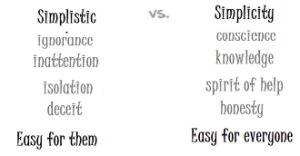
The thinking between simplism and simplicity
Naive thinking ignores the complexity, relief and depth of things see them in the superficiality of their appearance, while simplicity initiates a phenomenological process that begins with the appearance of the beholder and then develops a greater perception, in the words of philosophy, the noema, that complements the initial phase of the ability to feel, the noesis.
see them in the superficiality of their appearance, while simplicity initiates a phenomenological process that begins with the appearance of the beholder and then develops a greater perception, in the words of philosophy, the noema, that complements the initial phase of the ability to feel, the noesis.
By defining complex thinking as having three principles: recursive, dialogic and hologrammatical, Edgar Morin thus explains this third that is inseparable from the other two:
“The hologram is a physical image, conceived by Gabor which, unlike ordinary photographic and filmic images, is projected into space in three dimensions, producing an astonishing sensation of relief and color. The holographed object is restored, in its image, with remarkable fidelity. This hologram is made up of coherent light (laser) and a device that makes each point that constitutes this image contain a sample of the system of interference lines emitted by the points of the holographed object” (MORIN, 2003, p. 34).
To explain and clarify certain phenomena it is necessary to use didactic resources that simplify them, however, this pedagogical task cannot mutilate the explanation nor make it absolutist.
There is nothing more complex than reducing it to the simple, as stated by Bachelard, there is no such thing as simple, there is only the simplified, which in most cases mutilates and deforms the phenomenon, inducing thought to an obscure liquidity.
Phenomena of nature are not easily simplified, often the pretension of mastering it even in scientific cases has revealed a perverse face, this has happened from atomic physics to modern communication technologies, it is necessary to predict and investigate adverse effects.
However, the simplicity of seeing the phenomena does not only depend on the culture, which is always diverse, but on the ability to reduce the idea (the eidetic reduction proposed by Husserl), where we go from simple appearance to the experience of consciousness about what it is informed by the senses and how the mind receives them, interpreting what is informed.
Simplifying always requires an analogy or a metaphor, we’ve already discussed it here, and that yes, it is necessary to be simple to receive “new” information with the disposition of a child, with an epoché, say philosophy, with a suspension of judgment, I would say, Cartesian thought .
MORIN, Edgar et al. (2003> Educar para a era planetaria: o pensamento complex como método parra aprendizagem. (Educating for the planetary era: complex thinking as a method of learning in human error and uncertainty). São Paulo: Editora Cortez.









